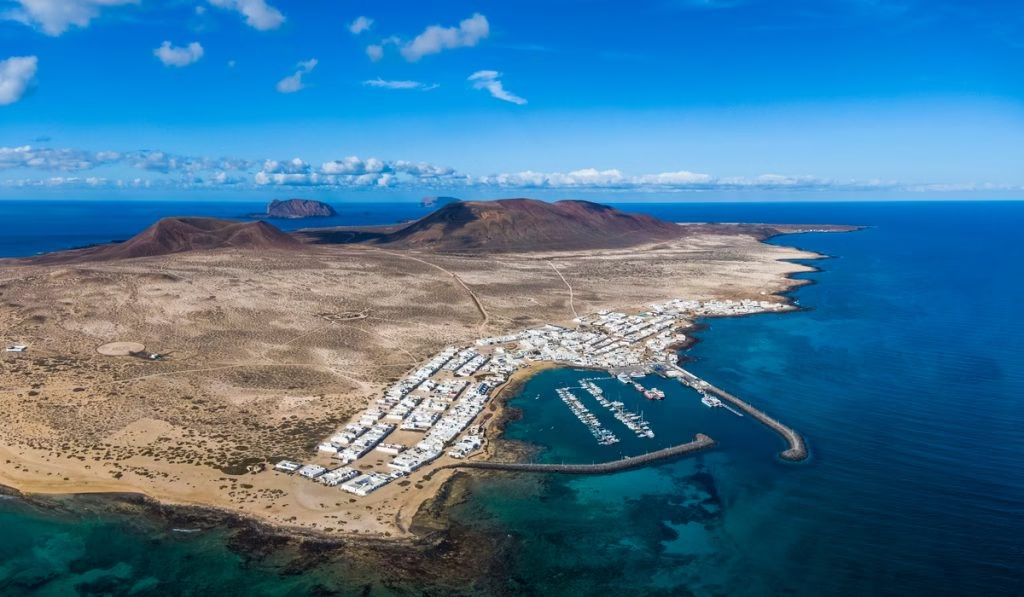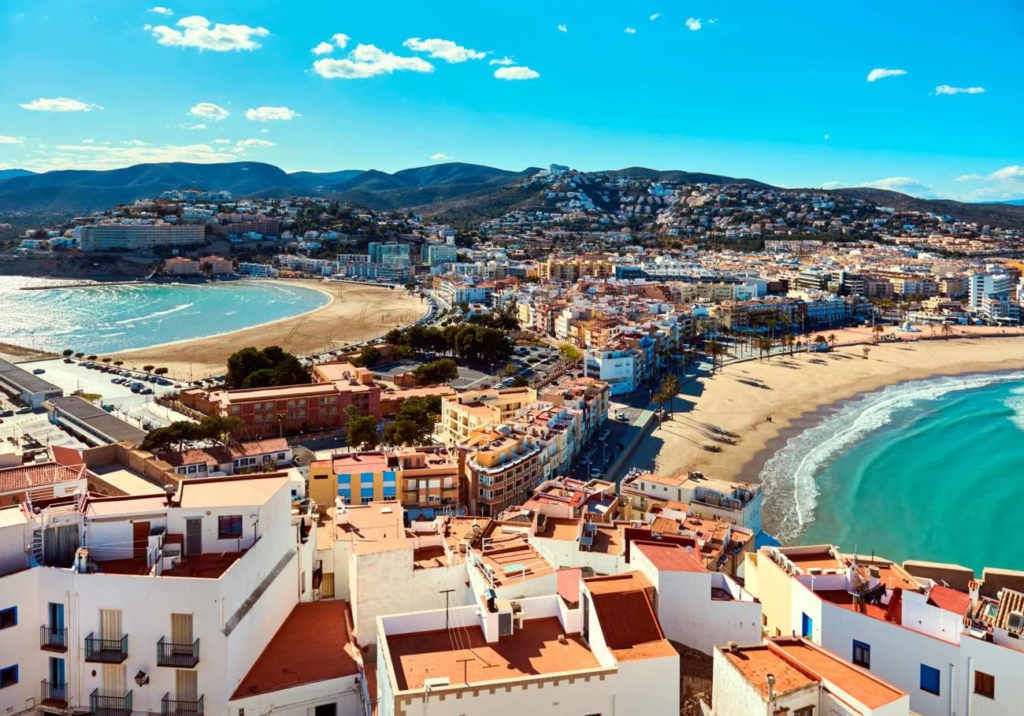La Graciosa: The Hidden Gem of the Canary Islands
La Graciosa is a small, unspoiled island off the northern coast of Lanzarote in the Canary Islands. This tranquil paradise spans approximately eight kilometers from north to south, and its total population is just over 700 people. Visitors who arrive here often feel like they have stepped back in time. No paved roads exist, and the air is pure, infused with salty breezes off the Atlantic. This article offers an in-depth tourist guide to La Graciosa, complete with travel tips, top attractions, FAQs, and an overview of why this destination should be on every traveler’s must-visit list.

Introduction to La Graciosa
La Graciosa is the smallest inhabited island in the Canary Islands archipelago. It is part of the Chinijo Archipelago and lies just a short ferry ride away from the town of Órzola in northern Lanzarote. The island is often referred to as “the eighth Canary Island,” a status recognized in 2018. Its landscape is defined by volcanic peaks, golden sandy beaches, and a peaceful atmosphere that contrasts sharply with busier nearby islands.
Background and Geography
Part of Chinijo Archipelago: This group of islands sits within a protected marine reserve known for its rich biodiversity.
Volcanic Origins: Much of La Graciosa’s terrain has striking volcanic features, including the famous Montaña Amarilla (Yellow Mountain).
Main Settlements: Caleta de Sebo, the island’s port and central hub, is where most residents live. Pedro Barba is a smaller settlement used mainly as a vacation spot.
Why Visit La Graciosa
La Graciosa appeals to nature lovers, beach enthusiasts, and anyone seeking a slow-paced break. It is a showcase of secluded coves, vibrant marine life, and pristine landscapes. Sustainable tourism is strongly encouraged here. As a result, you can roam the sandy paths on foot or by bike without worrying about traffic congestion.
Analyzing La Graciosa’s Allure
Tourism on La Graciosa has grown over the past decade, yet the island remains largely untouched by high-rise developments. Stringent environmental regulations help maintain its charm. New accommodations are limited, so visitor numbers stay manageable. This creates a calm and relaxed environment.
From an ecological standpoint, the island’s wildlife is thriving. Turtles, dolphins, and tropical fish are often spotted in nearby waters. Rare birds, including shearwaters and storm petrels, nest on sea cliffs. Many travelers, especially from Europe, view La Graciosa as the ideal place for sustainable, nature-based tourism.
How to Get to La Graciosa
Travelers reach La Graciosa via a short ferry crossing from Órzola in Lanzarote. The ferry ride takes about 25 to 30 minutes, depending on sea conditions. Ferries operate several times a day, but schedules may vary slightly according to the season. Booking tickets in advance is recommended during peak tourist periods.
Fly to Lanzarote: Most visitors land at César Manrique-Lanzarote Airport.
Drive or Bus to Órzola: Órzola is about 40 minutes by car from the airport, depending on traffic. Public buses also connect major tourist areas to this northern port.
Take the Ferry: The crossing is scenic, offering views of the Atlantic and the dramatic cliffs on the shoreline.
Once you arrive at the port of Caleta de Sebo, you can rent a bike or walk to your accommodation. The island’s roads are sandy, so four-wheel drive taxis are also available.
Top Beaches in La Graciosa
La Graciosa boasts some of the Canary Islands’ most beautiful beaches. They are mostly uncrowded, which makes them a treat for visitors seeking a peaceful getaway.
H3: Playa de Las Conchas
Playa de Las Conchas is often considered the finest beach on the island. It features a wide stretch of golden sand backed by dunes. Turquoise waters invite swimmers, but waves can be strong. Swim with caution, especially if you are not an experienced swimmer.
H3: Playa Francesa
Playa Francesa lies on the southern coastline, near Montaña Amarilla. The water here is calm, making it ideal for snorkeling. Many boat tours stop in this area because of the protected bay. This beach also offers views back toward Lanzarote.
H3: Playa de La Cocina
Playa de La Cocina sits at the foot of Montaña Amarilla. Its fine sand and crystal-clear waters are perfect for a relaxing day out. Snorkelers often head here for vibrant underwater sights. The tranquil atmosphere is another draw, with fewer crowds than other Canary Island beaches.
Best Activities on La Graciosa
The island’s natural beauty encourages outdoor exploration. Its small size makes it easy to navigate, whether on foot or by bicycle.
Cycling: Bike rental shops are common in Caleta de Sebo. The sandy tracks traverse the island, connecting major sites and scenic viewpoints.
Hiking: Trails lead to Montaña Amarilla and other volcanic landmarks. Carry enough water and wear sturdy footwear.
Snorkeling and Diving: La Graciosa forms part of a marine reserve. The waters around it teem with fish, rays, and even occasional sea turtles. Local dive centers offer guided excursions.
Boat Tours: Organized tours circle the island, stopping at beaches such as Playa Francesa and Playa de Las Conchas. Some tours include lunch and time for water sports.
Fishing: Recreational fishing is possible through licensed charters. The surrounding waters are rich in sea life, including tuna and local species.
Where to Stay in La Graciosa
Accommodation options in La Graciosa are primarily found in Caleta de Sebo. They range from simple guesthouses to a limited selection of apartment rentals. High-end hotels are nonexistent, which keeps the island’s ambiance low-key. Booking well ahead is essential, particularly during summer months and holiday seasons.
H3: Guesthouses and Apartments
Many of the island’s lodgings are family-run, offering friendly service and traditional Canary Island hospitality. Some apartments have kitchens, ideal for extended stays. You can find basic but comfortable rooms for a reasonable price, though costs may rise during peak travel periods.
Island Cuisine: Local Restaurants and Dishes
Fresh seafood dominates La Graciosa’s culinary scene. Restaurants commonly serve catch-of-the-day fish, octopus, and grilled prawns. Papas arrugadas (wrinkled potatoes) with mojo sauce is a Canary Islands staple worth trying. Local bars and eateries dot Caleta de Sebo’s waterfront, allowing you to enjoy ocean views while dining.
H3: Recommended Dining Spots
El Varadero: Known for its seafood paella and scenic terrace.
Casa Enriqueta: A family-run spot where the fried calamari is highly praised.
Girasol: Popular for fresh fish dishes, simple side salads, and friendly service.
Small supermarkets in Caleta de Sebo stock basic provisions. If you stay in an apartment with a kitchen, you can prepare your own meals using local ingredients. Fresh fish is sold by local fishermen in the mornings, depending on the season’s catch.
Best Time to Visit La Graciosa
La Graciosa enjoys a mild subtropical climate. Temperatures rarely drop below 15°C (59°F) in winter and can reach 28°C (82°F) in summer. Rainfall is minimal, and even when it occurs, showers are usually brief.
Spring (March to May): This season provides pleasant temperatures and fewer tourists.
Summer (June to August): Expect sunnier days but bigger crowds. Book accommodation and ferries in advance.
Autumn (September to November): Warm waters and less crowded beaches make it an ideal period for a relaxed visit.
Winter (December to February): Mild conditions persist, but you might experience occasional strong winds.
Embracing Sustainable Tourism
La Graciosa is part of a protected marine reserve, and conservation efforts here are robust. Locals strive to keep the environment pristine. Visitor guidelines emphasize responsible waste disposal and protection of marine life.
Respect Marine Life: Do not disturb sea creatures or coral. Avoid littering on beaches.
Stay on Marked Trails: Keep to designated paths to prevent erosion and protect vegetation.
Support Local Businesses: Buying goods from local vendors helps the island’s economy remain sustainable.
Sustainable travel also involves choosing eco-friendly accommodations where possible. Speak with property owners about their water and energy usage. The island’s resources are limited, so small actions can make a big difference.
Practical Tips for Your Stay
Cash and Cards: While some restaurants accept credit cards, having cash on hand is wise. ATMs are limited.
Pack Accordingly: Bring sun protection, a hat, and comfortable shoes or sandals suitable for walking on sandy roads.
Ferry Schedules: Keep an eye on the ferry timetable, especially if you plan day trips. Weather can affect service.
Mobile Connectivity: Cell phone coverage is generally good but can be spotty in certain remote areas.
Frequently Asked Questions (FAQs)
H3: 1. Do I need a car on La Graciosa?
Cars are heavily restricted and not practical due to unpaved roads. You can explore on foot, by bike, or by taking a four-wheel drive taxi.
H3: 2. How long should I stay on the island?
Many visitors come for a day trip. However, an overnight stay of two or three nights allows you to fully appreciate the island’s laid-back charm and see more beaches.
H3: 3. Is La Graciosa suitable for families?
Yes. Children enjoy the relaxed atmosphere, outdoor activities, and calm waters at beaches like Playa Francesa. Just remember to bring child-friendly sun protection, hats, and snacks.
H3: 4. Are there medical facilities on the island?
La Graciosa has a small medical center in Caleta de Sebo, but serious medical issues may require transfer to Lanzarote. Travel insurance is recommended.
H3: 5. Is it possible to camp on La Graciosa?
Official camping is restricted. However, some guided excursions include overnight stays in designated areas. Confirm local regulations before you go.
H3: 6. Can I visit La Graciosa year-round?
Yes. The island sees visitors in every season thanks to its mild climate. However, ferry schedules can vary slightly during winter.
Conclusion
La Graciosa is a pristine jewel in the Canary Islands that beckons nature enthusiasts, beach lovers, and those yearning for a peaceful retreat. It offers an enticing blend of volcanic landscapes, secluded beaches, and untouched ecosystems. The absence of paved roads underscores its serene allure, while friendly locals provide genuine hospitality. Whether you wish to hike volcanic trails, snorkel in protected waters, or simply unwind on golden sands, La Graciosa is an unforgettable destination.
By following sustainable tourism practices and respecting the island’s natural treasures, you can help preserve its unique character for generations to come. If you crave an escape from crowds and want to experience the Canary Islands’ more tranquil side, La Graciosa will leave you with memories of turquoise waters, unspoiled beaches, and breathtaking sunsets over the Atlantic.

